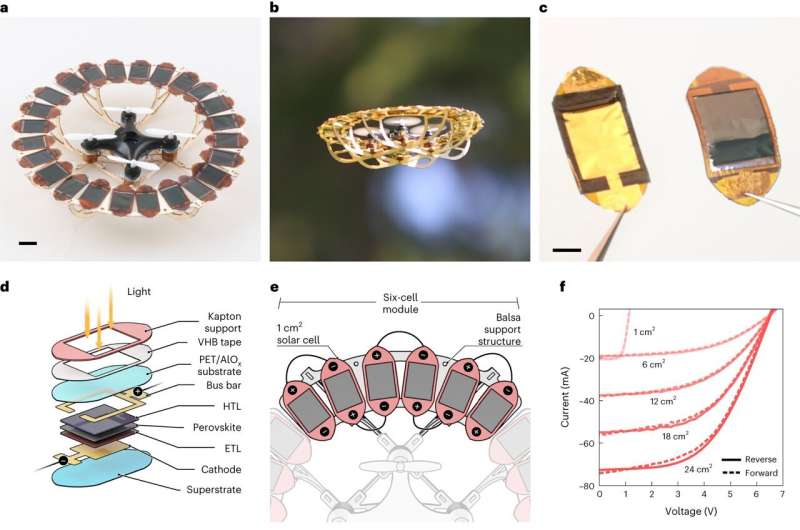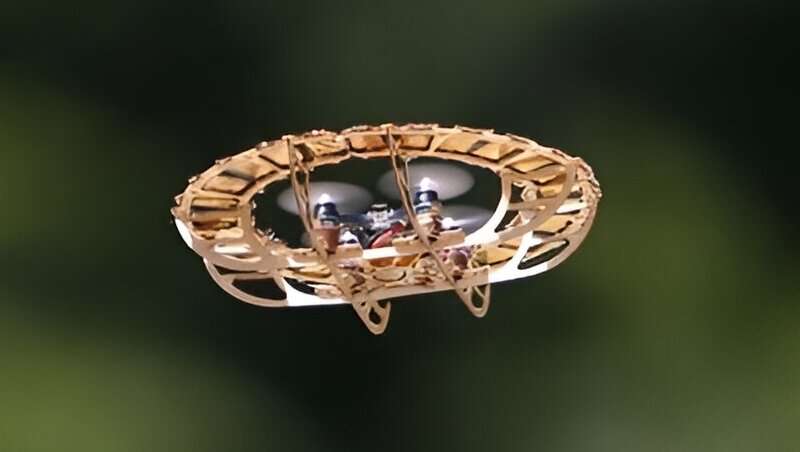
Whether on Earth or in space, autonomous energy is critical in order to keep power systems running independently for extended periods of time, particularly in remote or unpredictable environments.
Conventional energy solutions—including fossil fuels, batteries and other alternative energy generation methods—have their challenges. For example, they are either often too large, require cables or stationary charging, negatively impact on the environment, or their power density is too low.
Ultra-thin and flexible solar cells made from a new material called "perovskite" are proving to be an efficient and lightweight solution to facilitate self-sufficient energy generation over extended periods of time.
As part of a groundbreaking development, researchers at the JKU have now succeeded in developing ultra-lightweight quasi-2D perovskite solar cells with an unprecedented power output of up to 44 watts per gram and a comparatively high level of stability. The study is published in the journal Nature Energy.
Developing solar material
Christoph Putz, one of the study's lead authors, remarked, "Ultra-thin and lightweight solar cells not only have enormous potential to revolutionize the way energy is generated in the aerospace industry, there are also a wide range of applications that include wearable electronics, and the Internet of Things, that can also benefit from this new technology. Lightweight, adaptable and highly efficient photovoltaics are the key to developing the next generation of self-sufficient energy systems."

An ultralight and flexible solar cell module 20x thinner than a strand of human hair can power a wide range of electronics anywhere there is light. Less than 2.5 micrometers (1 micrometer = 1 millionth of a meter) thick, the quasi-2D perovskite solar cells deliver an impressive 20.1% efficiency while maintaining a high degree of flexibility. Above all, the remarkable power density of 44 W/g clearly sets it apart from other types of solar cell technologies.
In order to create operationally reliable, highly stable, and flexible solar cells with a high power-to-weight ratio, there needs to be a balance between low gas and moisture permeability, a high degree of flexibility and transparent plastic substrates combined with sturdy photovoltaic materials. The cells' operational stability was significantly improved by applying a transparent aluminum oxide layer to the thin film and then optimizing the solar cell material itself.
Technology for everyday use
To demonstrate their new technology's capabilities, researchers fitted a palm-sized, commercial quadcopter drone with the ultra-light solar cells. Twenty-four of these cells were seamlessly integrated into the drone's frame, making up just 1/400 of its total weight. The configuration enabled the drone to operate self-sufficiently and perform consecutive charge-flight-charge cycles without wired recharging, thereby demonstrating just how efficient and sustainable the solar cells are.
The new technology has potential applications in search and rescue operations, large-scale mapping, generating solar power in space, and exploring the solar system.
More recently, the Mars helicopter Ingenuity impressively demonstrated just how important self-sufficient solar-powered aviation is by being the first aircraft to successfully launch from Earth and land on another planet.
More information: Bekele Hailegnaw et al, Flexible quasi-2D perovskite solar cells with high specific power and improved stability for energy-autonomous drones, Nature Energy (2024). DOI: 10.1038/s41560-024-01500-2
Provided by Johannes Kepler University-Linz
Citation: Ultra-thin, flexible solar cells demonstrate their promise in a commercial quadcopter drone (2024, April 24) retrieved 24 April 2024 from https://techxplore.com/news/2024-04-ultra-thin-flexible-solar-cells.html
This document is subject to copyright. Apart from any fair dealing for the purpose of private study or research, no part may be reproduced without the written permission. The content is provided for information purposes only.
